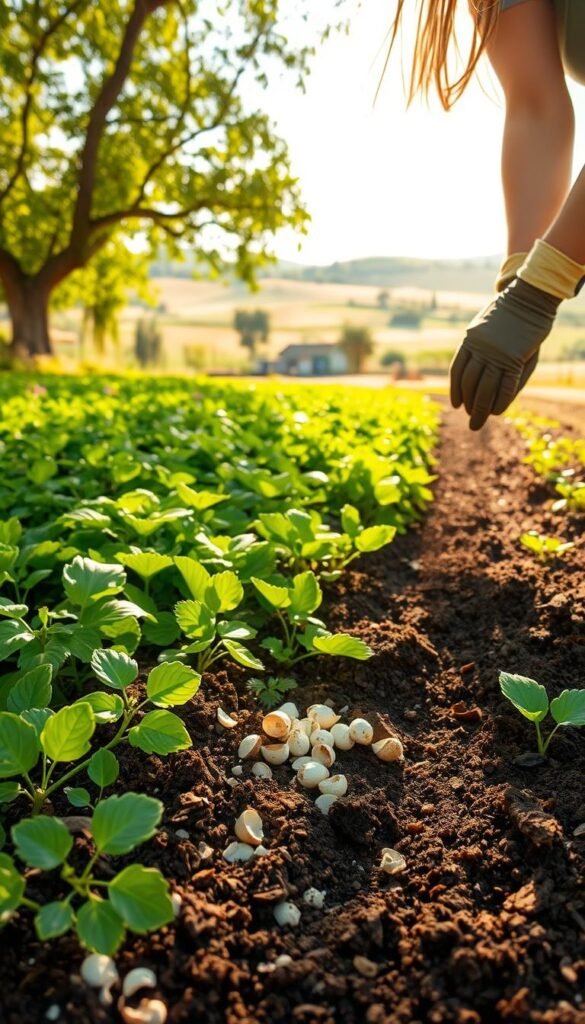Imagine stepping into your backyard and harvesting crisp vegetables or fragrant herbs without worrying about synthetic residues. This is the heart of nurturing your green space naturally—a practice that prioritizes health for both people and ecosystems. By focusing on simple, earth-friendly methods, you can transform your plot into a vibrant sanctuary.
Healthy soil is the cornerstone of every successful growing space. Rich in nutrients and teeming with life, it feeds your plants while resisting pests naturally. Enriching earth with decomposed organic matter, like kitchen scraps and yard waste, builds fertility over time. This “black gold” reduces waste and eliminates the need for artificial additives.
Choosing the right greenery for your climate and sunlight conditions ensures stronger growth. Pairing certain species together can even deter bugs naturally—marigolds with tomatoes, for example. These strategies create a balanced environment where pollinators thrive and harmful chemicals stay out.
Beyond personal benefits, these methods protect groundwater and support local wildlife. Your efforts contribute to cleaner air and soil for future generations. Plus, homegrown harvests often taste richer because they ripen naturally under your care.
This guide will walk you through selecting nutrient-dense soil blends, crafting natural pest solutions, and designing layouts that maximize yields. Whether you’re growing flowers or food, these principles help you cultivate a space that’s as kind to the earth as it is rewarding for you.
Understanding Organic Gardening and Its Benefits

Imagine a space where ladybugs patrol your greens and earthworms enrich the soil naturally. This approach works with nature rather than against it, creating a thriving environment where plants and wildlife support each other.
Why Choose an Organic Approach?
Conventional methods often rely on synthetic sprays that linger on food and seep into groundwater. By focusing on natural nutrients like compost and mulch, you feed your plants while building soil that retains water efficiently. Studies show gardens using these techniques experience 30% fewer pest issues thanks to balanced ecosystems.
Health and Environmental Advantages
Every chemical-free tomato or basil leaf you grow means fewer toxins entering your body. Health-conscious growers report tastier harvests, as plants develop robust flavors without artificial interference. Meanwhile, nearby birds and bees flourish—research confirms organic spaces host 50% more pollinators than treated yards.
This method also protects local waterways. Rainwater carries fewer pollutants when synthetic fertilizers aren’t used, keeping rivers cleaner for fish and communities. Over time, your garden becomes a self-sustaining habitat where every element works together naturally.
Preparing Your Garden and Soil for a Chemical-Free Haven
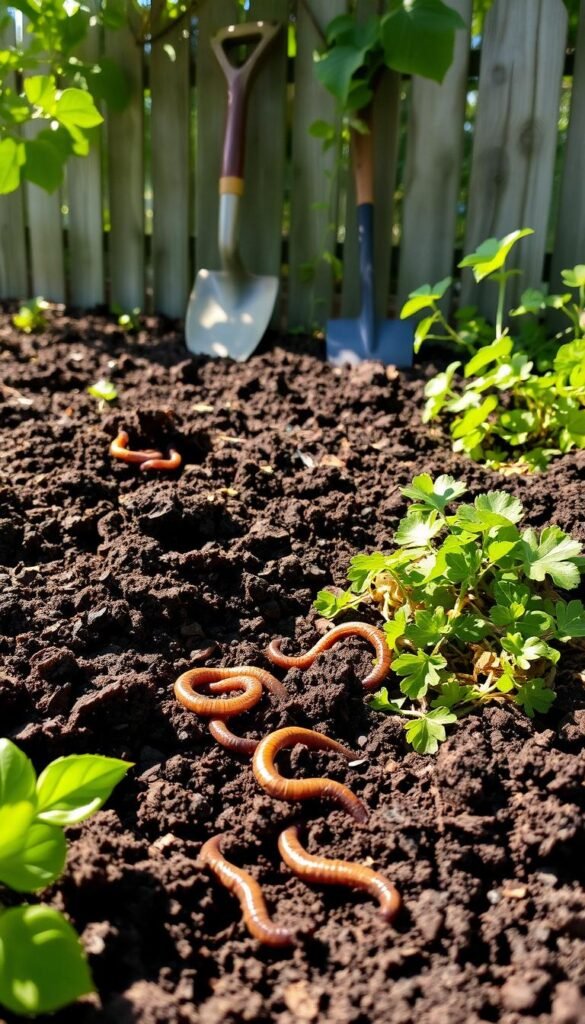
Think of your garden’s soil as its beating heart—healthy earth means thriving plants. To grow strong, resilient greenery without chemicals, focus first on building a nutrient-rich foundation. This upfront work pays off with fewer diseases and better harvests down the line.
Building Healthy, Nutrient-Rich Soil
Start by testing your yard’s dirt. Sandy or clay-heavy soils often need amendments like compost or aged manure. These natural fertilizers feed microbes that break down nutrients into plant-friendly forms. Over time, this creates a loose, crumbly texture that roots love.
Incorporating Organic Matter and Compost
Mix 3-4 inches of compost into your topsoil each season. This boosts drainage while retaining moisture—a perfect balance for most plants. For extra protection against diseases, layer mulch like straw or wood chips around stems. It smothers weeds and keeps soil temperatures steady.
| Material | Benefits | Best Time to Apply |
|---|---|---|
| Composted Manure | Adds nitrogen, improves texture | Early spring |
| Leaf Mold | Retains moisture, attracts worms | Fall |
| Grass Clippings | Quick nutrient release, weed suppression | Summer |
Rotate crops yearly to prevent soil depletion. For example, follow heavy feeders like tomatoes with nitrogen-fixing beans. This way, your yard stays productive without synthetic inputs. Remember: healthy soil is your best defense against pests and environmental stress.
Organic Gardening Basics: Creating a Chemical-Free Haven – Getting Started
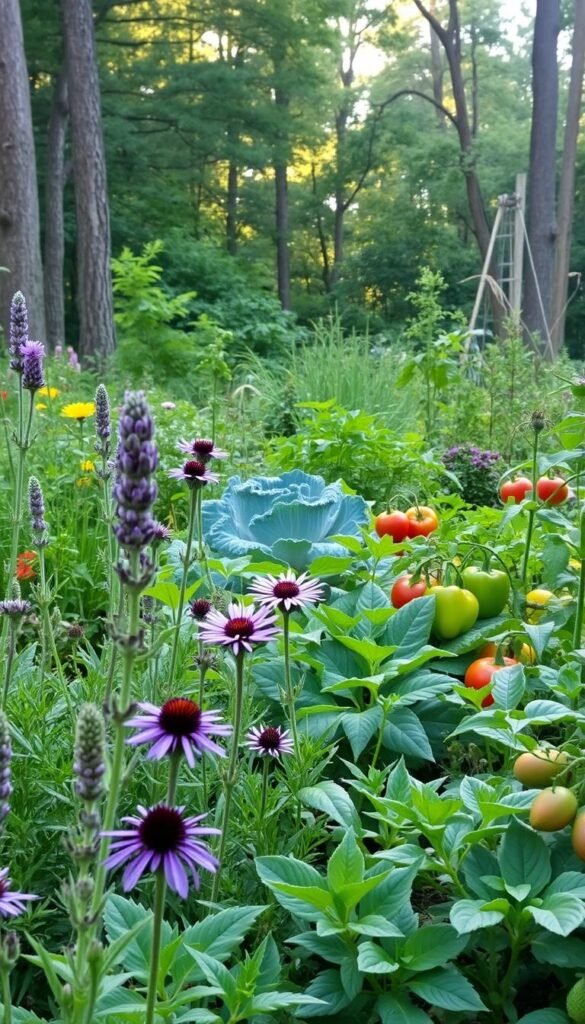
Your garden’s success begins with choosing plants that love your local weather as much as you do. Matching greenery to your region’s patterns means less stress and fewer interventions. This smart start lets nature do the heavy lifting while you enjoy healthier yields.
Selecting the Right Plants for Your Climate
Focus on varieties proven to thrive where you live. Heirloom tomatoes or native wildflowers, for example, adapt better to local pests and rainfall. Check seed packets or nursery tags for terms like “disease-resistant” or “zone-hardy.”
| Factor | Ideal Match | Materials to Use |
|---|---|---|
| Sunlight | 6-8 hours for veggies | Compost for shade-lovers |
| Soil Type | Sandy or clay-adjusted | Aged manure mix |
| Rainfall | Drought-tolerant natives | Mulch for moisture |
Natural fertilizers like fish emulsion feed plants without harsh chemicals. Pair them with materials such as leaf mold to boost soil structure. This combo supports strong roots and vibrant blooms through every season.
Struggling with short summers? Try quick-growing greens like spinach. In humid areas, opt for mildew-resistant squash. These choices reduce the need for sprays, letting your garden flourish through nature’s rhythms.
Remember: robust plants start with rich earth. Work organic matter into beds each spring to create a buffet for roots and worms. Your future harvests will thank you.
Essential Techniques for Natural Pest Control and Organic Fertilizers
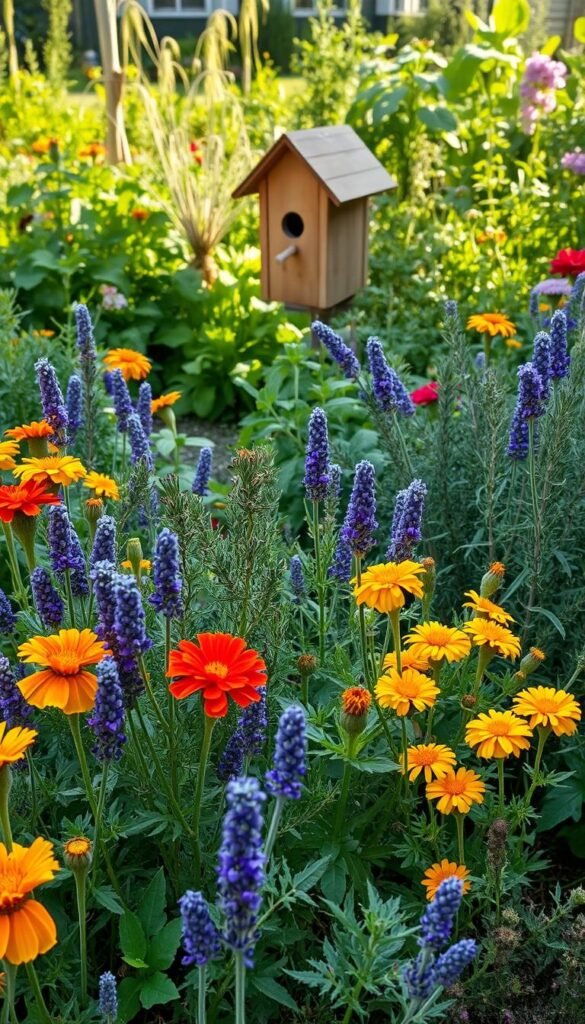
Picture this: Your plants thriving without a single spray bottle in sight. By working with nature’s rhythms, you can manage unwanted visitors while feeding your soil sustainably. Let’s explore two pillars of a balanced ecosystem: smart pest solutions and nutrient-rich amendments.
Utilizing Beneficial Insects and Companion Crops
Invite nature’s pest patrol to your yard. Ladybugs devour aphids, while lacewings target mites. Plant dill or yarrow to attract these helpers. For pest control that doubles as decor, grow marigolds near tomatoes—their scent repels nematodes.
Companion planting offers extra protection. Try basil with peppers to deter flies, or nasturtiums as a trap crop for cabbage moths. These pairings reduce the need to use natural sprays while boosting biodiversity.
Choosing Organic Fertilizers and Manure
Feed your soil, not just your plants. Composted manure adds nitrogen slowly, preventing nutrient burn. Mix in leaf mold for better water retention—especially useful in sandy soils.
| Fertilizer Type | Key Nutrients | Best For |
|---|---|---|
| Worm Castings | Nitrogen, Potassium | Seedlings & Containers |
| Fish Emulsion | Phosphorus, Trace Minerals | Fruiting Plants |
| Compost Tea | Balanced Microbes | Soil Rejuvenation |
When selecting seeds, opt for heirloom varieties adapted to your region. They often resist local pests better than hybrid types. For balcony growers, eco-friendly pest solutions like neem oil sprays work wonders without harming pollinators.
Remember: Healthy soil rich in organic matter grows stronger plants that shrug off invaders. Test your earth yearly and adjust amendments as needed—your garden’s resilience depends on it.
Smart Watering, Mulching, and Crop Rotation Strategies
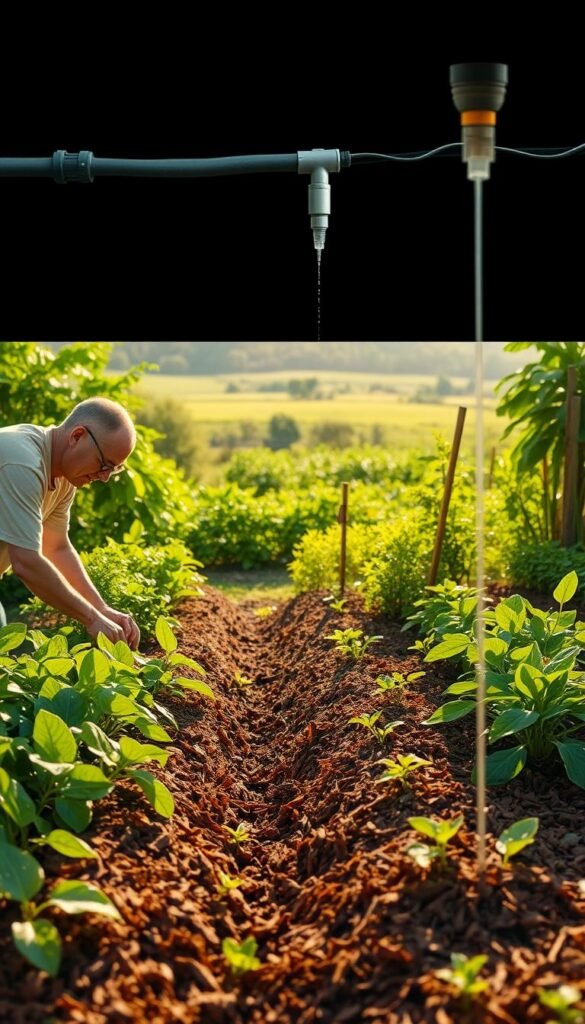
Watering your plants doesn’t have to mean wasting resources or relying on harsh solutions. By pairing clever techniques with nature’s rhythms, you’ll nurture stronger growth while keeping your space toxin-free. Let’s explore three pillars of low-effort, high-reward care.
Efficient Watering Methods and Natural Irrigation
Ditch the sprinkler! Soaker hoses deliver water straight to roots, cutting waste by 50% compared to overhead sprays. Water early morning or late evening to reduce evaporation. For larger plots, try drip systems with timers—they’re like a personalized hydration plan for your greens.
Mulching for Weed Control and Moisture Retention
A 3-inch layer of straw or shredded leaves blocks weeds naturally. It’s like a cozy blanket that keeps soil moist between rains. Bonus: As mulch breaks down, it feeds earthworms that aerate your beds.
| Mulch Type | Best For | Application Tip |
|---|---|---|
| Grass Clippings | Vegetable Beds | Apply thin layers to prevent matting |
| Pine Needles | Acid-Loving Plants | Use around blueberries or azaleas |
| Cardboard | New Garden Areas | Wet before laying to suppress grass |
The Benefits of Crop Rotation
Switching plant families each year confuses pests and prevents soil exhaustion. Follow nitrogen-hungry corn with peas that replenish it naturally. This simple shuffle can slash pest issues by 40% without chemicals.
Consistency matters. Track rotations in a journal—next year’s harvest will thank you. Pair these methods with compost tea for plants that thrive on autopilot.
Incorporating Companion Planting and Biodiversity in Your Garden
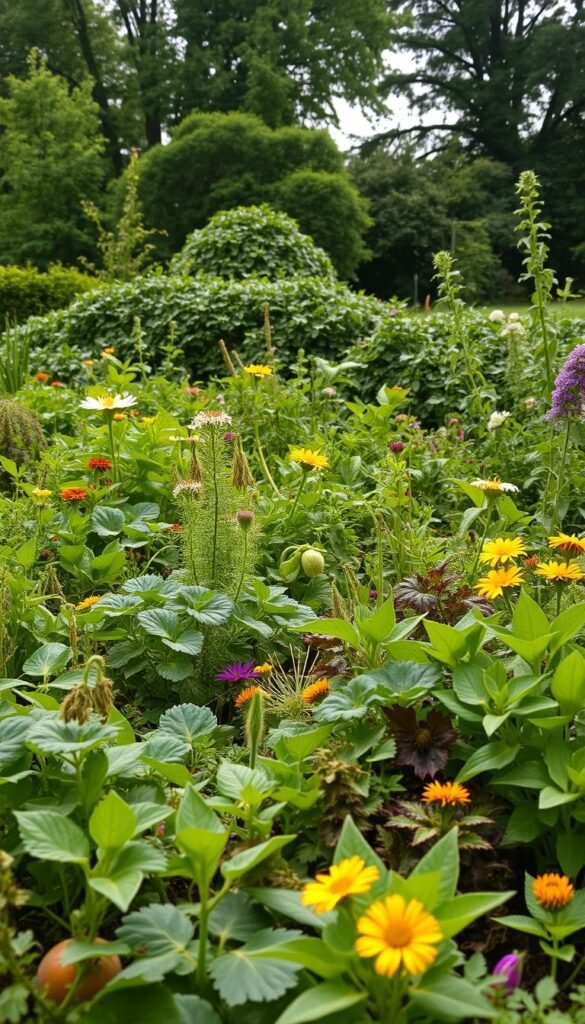
What if your garden could defend itself? By mixing specific plants and welcoming wildlife, you create a living network that naturally suppresses pests and boosts yields. This approach transforms your plot into a resilient, self-regulating environment where every element plays a role.
Attracting Pollinators and Natural Predators
Bees and butterflies aren’t just pretty visitors—they’re essential workers for crops like squash and berries. Plant sunflowers or lavender to draw them in. Meanwhile, ladybugs and lacewings feast on aphids, reducing the need for sprays. A small water source or native flowers keeps these helpers around all season.
Healthy soil teems with microorganisms that break down nutrients and fight diseases. Add compost regularly to feed these invisible allies. Clover or vetch planted between rows fixes nitrogen, enriching earth for future vegetables.
| Plant Pair | Benefits | Pollinators Attracted |
|---|---|---|
| Basil + Tomatoes | Repels flies, enhances flavor | Honeybees |
| Marigolds + Beans | Deters beetles, improves growth | Butterflies |
| Nasturtiums + Cucumbers | Traps aphids, prevents mildew | Hummingbirds |
Interplanting tall and short crops shades out weeds naturally. Try corn with leafy greens—the stalks support peas while blocking sunlight from invaders. This method can increase yields by 20% compared to monoculture beds.
Remember: Diversity is your garden’s best defense. Rotate crops yearly and let some herbs flower to sustain beneficial insects. Your environment becomes a balanced ecosystem where problems solve themselves.
Long-Term Maintenance: Educate and Monitor Your Organic Garden
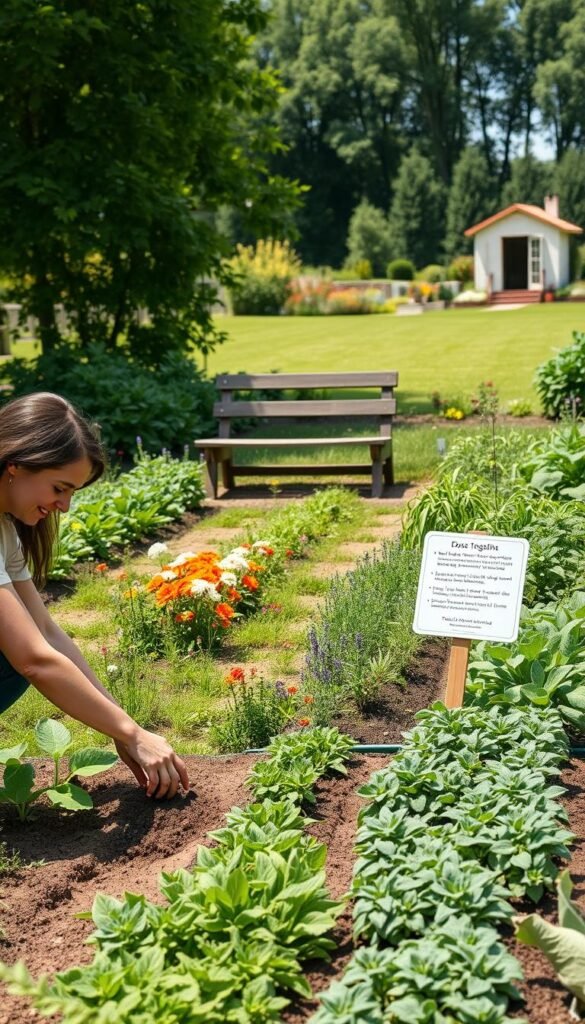
Your garden thrives when you stay curious and alert—like a living classroom that evolves with each season. Regular checks and small adjustments keep plants robust while preserving nature’s delicate balance. This proactive approach helps you spot issues before they escalate, ensuring your space remains vibrant year after year.
Continual Learning and Observation
Set aside time weekly to inspect leaves for discoloration or holes—early signs of pest activity. Check soil moisture by squeezing a handful; crumbly texture means it’s time to water. For tomatoes, watch for yellowing lower leaves, which may signal nutrient deficiencies.
Keep a journal to track changes. Note which steps worked, like adding eggshells to deter slugs or rotating crops to prevent disease. Composting scraps like coffee grounds and banana peels enriches soil naturally, reducing reliance on synthetic pesticides.
| Weekly Check | Action | Tool |
|---|---|---|
| Soil pH | Adjust with lime or sulfur | Testing kit |
| Beneficial Insects | Count ladybugs/lacewings | Magnifying glass |
| Compost Progress | Turn pile, add browns/greens | Pitchfork |
Join local workshops or follow experts who share pesticide-free solutions. Many offer text-to-speech articles or podcasts—perfect for learning while tending plants. For those growing in small spaces, mastering container gardening basics ensures healthy roots and better yields.
Adapt your strategies as needed. If aphids plague your tomatoes, introduce ladybugs instead of reaching for sprays. When scraps accumulate, refresh your compost bin to maintain nutrient balance. Remember: every observation sharpens your skills, turning challenges into opportunities for growth.
Your Path Forward: Embracing a Healthier, Chemical-Free Garden
Ready to transform your patch of earth into a thriving sanctuary? Every choice you make—from soil care to pest management—shapes a greener future. By focusing on natural methods, you’re not just growing plants but nurturing an ecosystem.
Composted manure and leaf mold keep soil bursting with life, reducing reliance on synthetic additives. Studies show gardens using these amendments yield 25% more while supporting local wildlife. Your vibrant tomatoes or crisp greens become living proof that nature knows best.
Each successful harvest is a testament to your efforts. Those juicy peppers or fragrant herbs? They’re more than food—they’re examples of what’s possible without harsh interventions. Share surplus veggies with neighbors or swap seeds to inspire others.
This journey isn’t about perfection. It’s about progress. Rotate crops, experiment with companion plants, and enrich beds with manure each season. Every small step strengthens your garden’s resilience and protects waterways from runoff.
Join online forums or local clubs to exchange tips. Your thriving plot sets an example, showing how delicious, abundant harvests stem from patience and earth-friendly care. Together, we’re cultivating healthier communities—one seed at a time.

